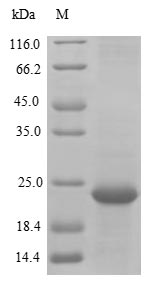Recombinant Pongo abelii Transmembrane protein 168 (TMEM168) is expressed in E. coli, covering the amino acid region 527-637. This partial protein product features an N-terminal 10xHis-tag and a C-terminal Myc-tag for enhanced purification and detection. The protein shows a purity greater than 85%, as confirmed through SDS-PAGE analysis, which appears to ensure reliable results in experimental applications.
TMEM168 likely plays a role in cellular processes involving membrane dynamics and signaling. As a transmembrane protein, it seems to be implicated in various pathways related to cellular communication and structural integrity. Understanding TMEM168's function may be crucial for research in membrane biology and related fields, potentially offering insights into cell signaling and structural maintenance.
Potential Applications
Note: The applications listed below are based on what we know about this protein's biological functions, published research, and experience from experts in the field. However, we haven't fully tested all of these applications ourselves yet. We'd recommend running some preliminary tests first to make sure they work for your specific research goals.
Pongo abelii TMEM168 is a transmembrane protein that requires precise folding, proper membrane integration, and specific tertiary structure for its functional activity. The E. coli expression system cannot provide the eukaryotic membrane environment or post-translational modifications required for this type of protein. The partial fragment (527-637aa) lacks the complete structural context and transmembrane domains essential for full functionality. The dual N-terminal 10xHis-tag and C-terminal Myc-tag may cause significant steric interference and prevent proper folding. The probability of correct folding with functional activity is extremely low.
1. Antibody Development and Epitope Mapping
This application is suitable for generating antibodies against linear epitopes within the 527-637aa region. Antibody development relies on antigenic sequence recognition rather than functional protein folding. However, antibodies may not recognize the native, membrane-integrated protein in its physiological context.
2. Structural and Biophysical Characterization Studies
Basic biophysical analysis can be performed, but will not reflect the native TMEM168 structure. Techniques like circular dichroism spectroscopy may detect secondary structure but cannot verify proper folding of a transmembrane domain without its membrane environment. The tags will dominate the protein's physical properties.
Final Recommendation & Action Plan
This dual-tagged TMEM168 fragment expressed in E. coli is unsuitable for functional studies due to the essential requirements for membrane integration that cannot be met in this expression system. The protein should not be used for interaction studies and comparative analysis. Application 1 (antibody development) can proceed for generating linear epitope antibodies. Application 2 provides only basic physical characterization of the fragment. For reliable TMEM168 research, use a full-length protein expressed in mammalian systems with proper membrane integration.






